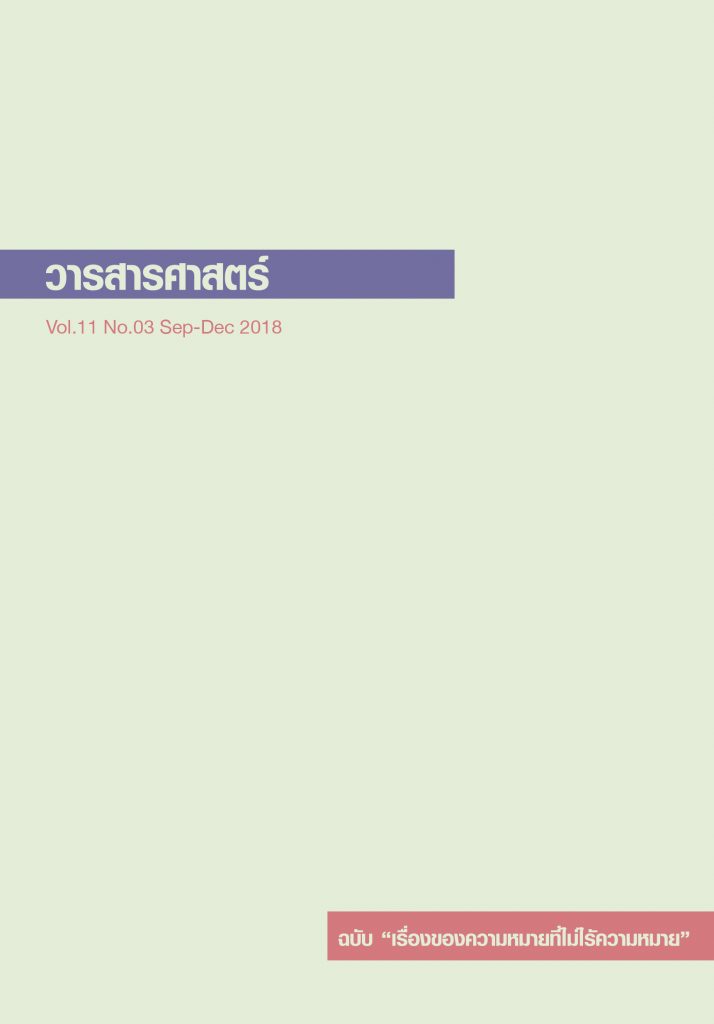การลดทอนและรื้อความเป็นตะวันตกด้านการสื่อสารศึกษา: การสำรวจและการวิเคราะห์
คำสำคัญ:
การลดทอนและรื้อความเป็นตะวันตก, ยุโรป-อเมริกานิยม, เอเชียนิยม, ทฤษฎีภูมิวัฒนธรรม, โลกาภิวัตน์, ทฤษฎีหลังอาณานิคมบทคัดย่อ
งานวิจัยเรื่อง การลดทอนและรื้อความเป็นตะวันตกด้านการสื่อสารศึกษา: การสำรวจและการวิเคราะห์ มีวัตถุประสงค์เพื่อ (1) สำรวจภาพวาทกรรม วิชาการด้านการสื่อสารและสื่อมวลชนศึกษา (2) เพื่อศึกษาแนวคิดการลดทอน/รื้อความเป็นตะวันตก (De-Westernization) ของการสื่อสารศึกษาในมิติต่างๆ (3) เพื่อศึกษาความสัมพันธ์ระหว่างแนวคิดการลดทอน/รื้อความเป็นตะวันตก กับกระบวนทัศน์กรอบแนวคิดทฤษฎีและแนวทางการศึกษาในอนาคต
ผลการศึกษาพบว่า (1) อิทธิพลของตะวันตกปรากฏให้เห็นอย่างเด่นชัด โดยเฉพาะแนวแองโกล-อเมริกัน และยุโรปนิยม ทั้งนี้เพราะสาขาถือกำเนิดมาจากทั้งในด้านประเพณี/กรอบมุมมองเชิงสังคมศาสตร์ตะวันตก จึงนำไปสู่การเรียกร้องวิธีวิทยาแนวแอฟโฟร/เอเชียนิยม และทฤษฎีภูมิวัฒนธรรม
(2) แนวคิด De-Westernization เป็นสะพานนำไปสู่ความตื่นตัวทางวิชาการ ทำให้นักวิชาการทั้งทางด้านตะวันตกและตะวันออกต้องหันกลับมาพิจารณาเกี่ยวกับการครอบงำของตะวันตกต่อวาทกรรมวิชาการในตะวันออก ทั้งในมิติด้านหัวข้อ/ประเด็นการศึกษา มิติด้านองค์ความรู้ มิติด้านกรอบมุมมองทฤษฎี และวิธีวิทยาในการศึกษา ตลอดจนมิติด้านวัฒนธรรมวิชาการ
(3) ความพยายามในการเคลื่อนย้ายเชิงญาณวิทยาจากแนวความคิด คับแคบ หรือการอิงยุโรปเป็นศูนย์กลาง ซึ่งนิยามวิธีวิทยาการวิจัยในโลกนี้ มาเป็นเวลานาน
(4) ความพยายามในการประนีประนอมทางความคิดระหว่างตะวันตกและตะวันออกที่มีลักษณะเป็นวัฒนธรรมสากลและวัฒนธรรมเฉพาะตามลำดับ ด้วยการเสนอแบบจำลอง C/I ของ Wang
เอกสารอ้างอิง
________. (2557), “การวิเคราะห์ภูมิปัญญาด้านการสื่อสารของท้องถิ่น”, วิถีสังคมมนุษย์, 2 (1): 1-27.
กาญจนา แก้วเทพ และสมสุข หินวิมาน (2545), “คติชนบนถนนโฆษณา”, ใน กาญจนา แก้วเทพ (บ.ก.), เมื่อสื่อส่องและสร้างวัฒนธรรม, กรุงเทพฯ: โรงพิมพ์ศาลาแดง.
ชวนี ทองโรจน์ (2554), “การวิจัยวัฒนธรรมเพื่อพัฒนาภูมิปัญญาท้องถิ่น”, วารสารมนุษยศาสตร์และสังคมศาสตร์, 7 (1): 129-138.
ไชยรัตน์ เจริญสินโอฬาร (2557), รัฐศาสตร์แนววิพากษ์, กรุงเทพฯ: มหาวิทยาลัยธรรมศาสตร์.
ธิกานต์ ศรีนารา (2557), “การเคลื่อนไหวทางภูมิปัญญาของ “ปัญญาชนกลุ่มวิถีทรรศน์” ในยุค โลกาภิวัตน์ (ระหว่าง พ.ศ. 2540-2550)”, เวทีวิจัยมนุษยศาสตร์ไทย, 8 (2): 503-528.
พยุรี ชาญณรงค์ (2543), การวิเคราะห์และวิจารณ์วาทะ, กรุงเทพฯ: โครงการวิจัยเสริมหลักสูตร มหาวิทยาลัยธรรมศาสตร์.
วงหทัย ตันชีววงศ์ (2554), การโฆษณาข้ามวัฒนธรรม, กรุงเทพฯ: มหาวิทยาลัยธรรมศาสตร์.
สุภาวดี เชื้อพราหมณ์ และอรศิริ ปาณินท์ (2556), “การอ่าน ความเปลี่ยนแปลงและหลากหลายของชุมชน และสถาปัตยกรรมพื้นถิ่น”, วารสารสังคมลุ่มน้ำโขง, 9 (1): 131-154.
อรนุช เลิศจรรยารักษ์ (2558), “ความเป็นไปได้ในการก่อตัวขององค์กรข่าว ASEAN News Net-work: มุมมองขอประเทศไทย”, วารสารศาสตร์, 8 (2): 88-91.
อัญนิดา น้อยวงศ์ (2556), “การวางกรอบความคิดเกี่ยวกับ “ศาสนาอิสลาม” ในหน้าหนังสือพิมพ์ ภาษาอังกฤษของประเทศสมาชิกในประชาคมอาเซียน”, อัล-ฮิกมะฮฺ, 3 (5): 105-114.
อุบลรัตน์ ศิริยุวศักดิ์ (2542), ระบบวิทยุและโทรทัศน์ไทย โครงสร้างทางเศรษฐกิจการเมืองและผลกระทบต่อสิทธิเสรีภาพ, กรุงเทพฯ: จุฬาลงกรณ์มหาวิทยาลัย.
Ang, I. (2005), On Not Speaking Chinese: Living Between Asia and the West, London: Psychology Press.
Alates S. (2002), “Eurocentrism and the Role of the Human Sciences in the Dialogue among Civilizations”, The European Legacy, 7 (6): 759-770.
Bruggermann, M. and Wessler, H. (2014), “Transnational Communication as Deliberation, Ritual, and Strategy”, Communication Theory, 24 (4): 394-414.
Curran, J. and Park, M. (2000), De-Westernizing Media Studies, London: Routledge.
Dissanayake, E. (2009), “The ArtificationHypothesis and Its Relevance to Cognitive Science, Evolutionary Aesthetics, and Neuroaesthetics”, Cognitive Semiotics, 5: 148-173.
Foss, K. and Littlejohn, S. (2008), Theories of Human Communication, Massachusetts: Cengage Learning.
Gunaratne, S. (2005), The Dao of the Press: A Humanocentric Theory, New Jersey: Hampton Press.
________. (2009), “Globalization: a Non-Western Perspective: The Bias of Social Science/ Communication Oligopoly”, Communication, Culture & Critique, 2 (1): 60-82.
________. (2010), “De-Westernizing Communication/Social Science Research: Opportunities and Limitations”, Media, Culture & Society, 32 (3): 473-500.
Gunaratne, S.A. (2005) The Dao of the Press: A Humanocentric Theory. Cresskill, NJ: Hampton Press.
Iwabushi, K. (2010), “Globalization, East Asian Media Cultures and Their Publics”, Asian Journal of Communication, 20 (2): 197-212.
Kincaid, L. (1987), Communication Theory: Eastern and Western Perspectives, New York: Academic Press.
Lang, A. (2013), “Discipline in Crisis? The Shifting Paradigm of Mass Communication Research”, Communication Theory, 23 (1): 10-24.
McComb, M. and Shaw, D. (1972), “The Agenda-Setting Function of Mass Media”, The Public Opinion Quarterly, 36 (2): 176-187.
McGrew, A. and Lewis, P. (1992), Global Politics: Globalization and the Nation-State, Cambridge: Polity Press.
McQuail, D. (2000), Mass Communication Theory, London: Sage.
Miike, Y. (2010), “An Anatomy of Eurocentrism in Communication Scholarship: The Role of Asiacentricity in De-Westernizing Theory and Research”, China Media Research, 6 (1): 1-11.
Mignolo, W. (2012), Local Histories/Global Designs Coloniality, Subaltern Knowledges, and Border Thinking, New Jersey: Princeton University Press.
Neuman, R. et al. (2014), “The Dynamics of Public Attention: Agenda‐Setting Theory Meets Big Data”, Journal of communication, 64 (2): 193-214.
Ray, T. (2012), “To De-Westernize, Yes, But with a Critical Edge: A response to Gunaratne and Others”, Media, Culture & Society, 34 (2): 238-249.
Rubin, A. and Babbie, E. (1997), Research Methods for Social Work, California: Thomson.
Starosta, W. (1993), Ferment in the Intercultural Field: Axiology/Value/Praxis, London: Sage.
Takahashi, T. (2010), Audience Studies: A Japanese Perspective, London: Routledge.
Thussu, D. (2014), De-Americanizing Soft Power Discourse?, Los Angeles: Figueroa Press.
Tomlinson, J. (1999 & 2001), Globalization and Culture, Cambridge: Polity Press.
Waisbord, S. and Mellado, C. (2014), “De‐Westernizing Communication Studies: A Reassessment”, Communication Theory, 24 (4).
Wang, G. (2014), “Culture, Paradigm, and Communication Theory: A Matter of Boundary or Commensurability?”, Communication Theory, 24 (4).
Wang, G. and Kuo, E. (2010), “The Asian Communication Debate: Culture-Specificity,Culture- Generality, and Beyond”, Asian Journal of Communication, 20 (2): 152-165.
Willems, W. (2014), “Provincializing Hegemonic Histories of Media and Communication Studies Toward a Genealogy of Epistemic Resistance in Africa”, Communication Theory, 24 (4).
สื่อออนไลน์
Glück, A. (2015), “De-Westernisation Key Concept Paper”, Media, Conflictand Democrati-sation, retrieved from https://eprints.whiterose.ac.uk/117297/1/Glueck%202016_ De-Westernisation.pdf
Kuhn, T. (1962), The Structure of ScientificRevolutions, retrieved from https://projektinte-gracija.pravo.hr/_download/repository/Kuhn_Structure_of_Scientific_Revolutions.pdf
Ullah, M. (2014), “De-Westernizing of Media and Journalism Education in South Asia: In Search of a New Strategy”, China Media Research, retrieved from https://chinamediaresearch.net/ index.php/10-china-media-research/back-issues/








